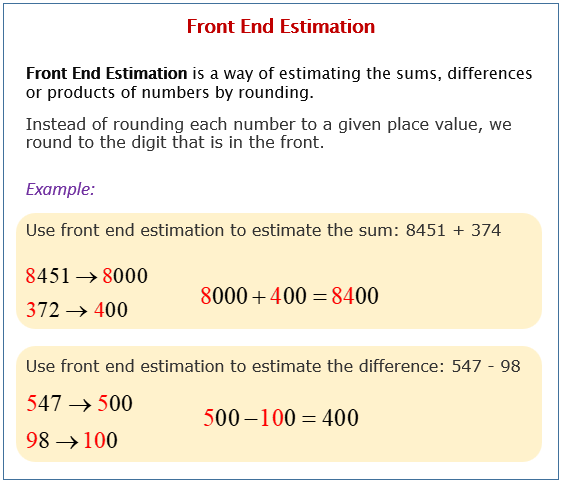Front End Estimation and Compatible Numbers
Videos, examples, solutions, worksheets, stories and songs to help Grade 6 students learn about Front End Estimation and Compatible Numbers.
The following diagram shows some examples of using Front End Estimation. Scroll down the page for more examples and solutions.

Front End Estimation (Rounding)
Front End Estimation is a way of estimating the sums, differences or products of numbers by rounding.
We first round each number to its leftmost place values and then perform the operation.
Example:
To add 67+ 24
Round each number using front-end estimation and then add
70 + 20 = 90
Front end rounding
This video explains what front end rounding is and how to apply it to a couple of examples. It works like normal rounding except we always round to the largest place value.
Front End Estimation (Truncate)
Another way of Front End Estimation is to truncate each number to its leftmost place values and then perform the operation.
Example:
To add 67+ 24
Truncate each number using front-end estimation and then add
60 + 20 = 80
Front End Estimation for Addition
Examples:
- 3279 + 2387
- 5238 + 351
Using Front end estimation to check that your answer is reasonable
Example:
Find the sum or the difference.
Then use front-end estimation to check that your answer is reasonable.
- 614 + 283
- 713 - 398
Use Front End Estimation for Multiplication
Learn to use front end estimation
Compatible Numbers
Compatible numbers are often used when estimating division. Compatible numbers are numbers that are close to the original numbers but they divide evenly into each other.
How to use rounding, front-end estimation, and compatible numbers to estimate in the appropriate situation?
Describe three estimation strategies: rounding, front-end estimation, and using compatible numbers.
Three Kinds of Estimation
This video looks at Front-End Estimation, Clustering, and using Compatible Numbers. It includes six examples.
Examples:
Front End Estimation
3025 + 498 + 32
613 + 91 + 1231
Clustering
51 + 48 + 53 + 50 + 47
95 + 103 + 99 + 97 + 101 + 104
Compatible Numbers
73.8 ÷ 7.9
22.6 ÷ 3.04
Estimating with Whole Numbers
This video explains how to estimate addition, subtraction, multiplication, and division math problems by using rounding and compatible numbers.
Poem for rounding numbers
Find your number.
Look right next door.
4 or less ignore.
5 or more, add 1 more.
Estimating with addition
Step 1: Line up your numbers vertically.
Step 2: Remember the rounding rules: Find your number(s) and circle them.
Step 3: Look right next door to decide to ignore or add 1 more.
Step 4: Solve.
When wee multiply or divide, we can use compatible numbers to estimate. Compatible numbers are close to the actual numbers and are easy to compute mentally.
How to estimate quotients using compatible numbers?
Examples:
6,481 ÷ 8
7,132 ÷ 9
3,413 ÷ 5
4,436 ÷ 7
Try the free Mathway calculator and
problem solver below to practice various math topics. Try the given examples, or type in your own
problem and check your answer with the step-by-step explanations.

We welcome your feedback, comments and questions about this site or page. Please submit your feedback or enquiries via our Feedback page.